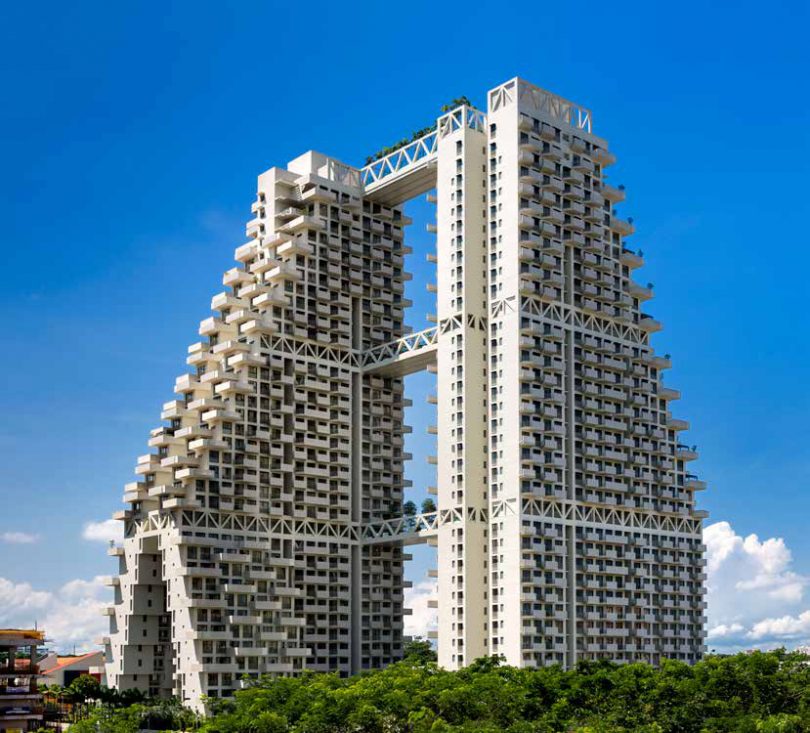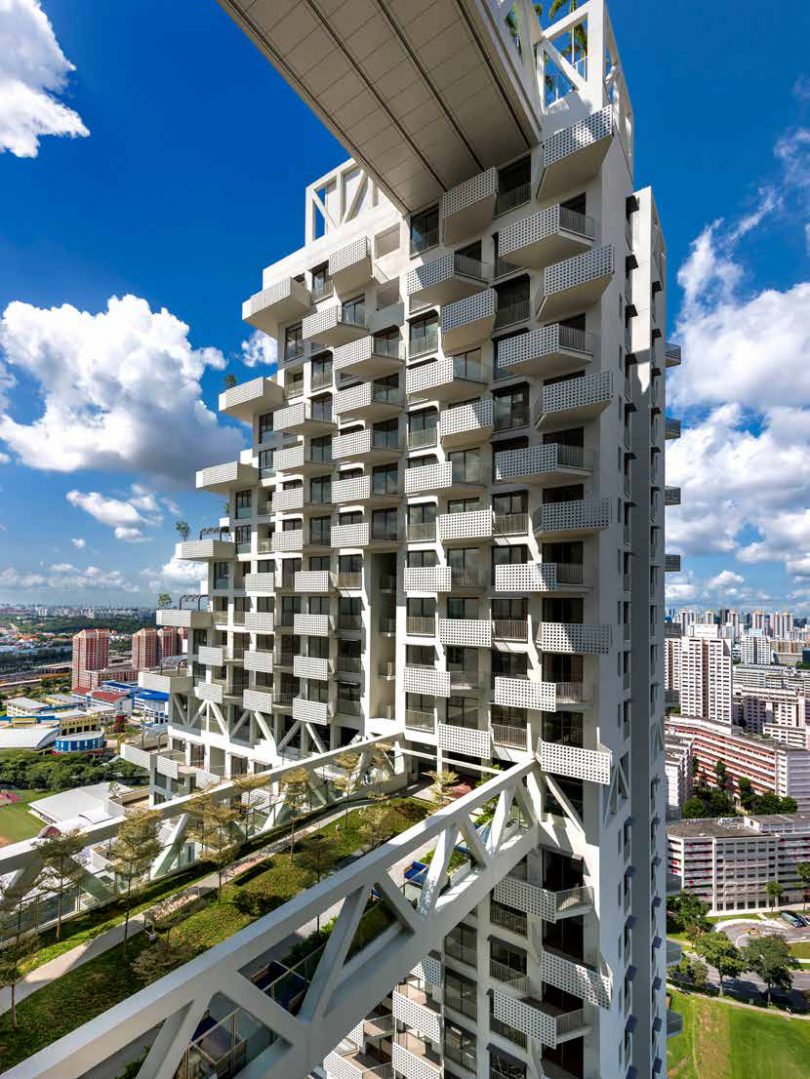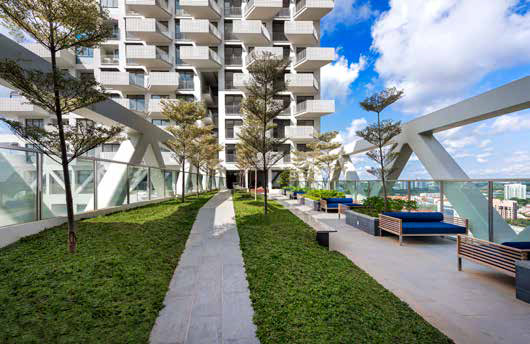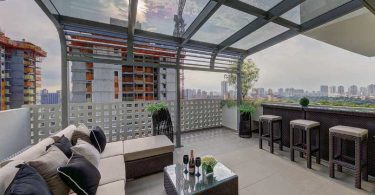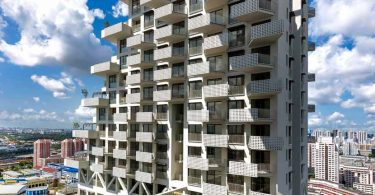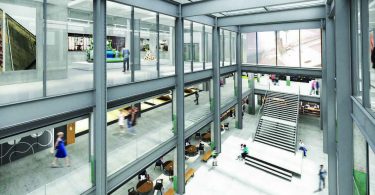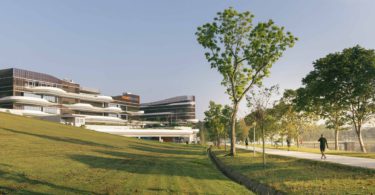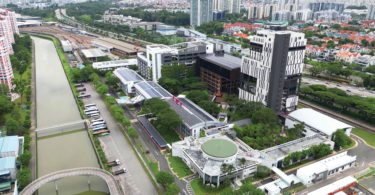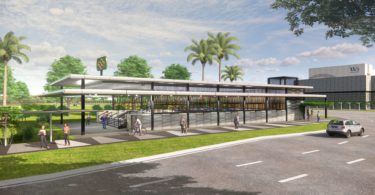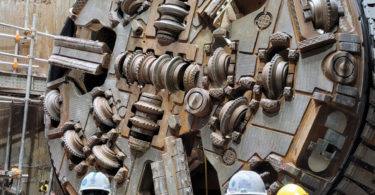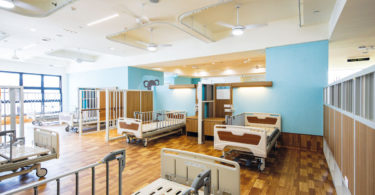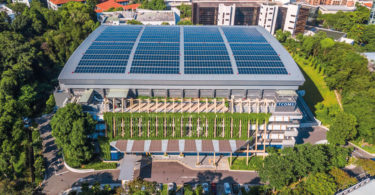Sky Habitat, located in the suburban heartland of Bishan, Singapore, introduces a whole new condominium lifestyle concept, with functional unit layouts and quality outdoor communal spaces.
Designed by the legendary Moshe Safdie, the development explores the balance of high-density living with humanistic concepts of community, landscape, gardens and daylight, making it an iconic landmark that would both transform and enhance the dynamics of the surroundings and urbanscape.
The design of Sky Habitat responds to the Singaporean culture and context, conforming to the generic core principles of providing air and light, windows that do not overlook neighbours, and spaces for both indoor and outdoor living. At Sky Habitat, 50 years since its original namesake was built at Expo ’67, these principles are applied to city-fringe living at much greater densities.
STEPPING TOWERS
The strongest visual feature of Sky Habitat is the stepped elevation of the towers. This stepping geometry allows every residence multiple orientations and a private outdoor terrace space. The north tower also splays at its base for additional terraces all the way to the ground, while a 15-storey-tall atrium under it merges into the surrounding recreational spaces.
The two 38-storey towers are arranged diagonally staggered from one another to maximise the potential of the irregularly shaped site and to provide unobstructed north-south views for all 509 apartment units. The towers hug closely to the allowable setbacks and green buffers to allow for a 30-metre gap between them.
The building is perforated and permeated by large openings along its structure. This openness allows for natural air circulation and cross ventilation, reducing the need for air-conditioning and minimising annual energy consumption.
GARDENS IN THE SKY
As the building structure rises, apartments were designed in pairs so that a three-bedroom unit stacks atop another three-bedroom type, with slight variation in scale as each steps back upon the next.
Each apartment is designed with a minimum of one garden terrace, staggered left and right—the bottom unit of a pair has a terrace projecting to the north or south, while the top unit’s terrace projects to the east or west—giving some homeowners a double-height balcony space. All other openings without balconies have Juliet-style railings so that homeowners can open the rooms entirely to the exterior.
As a by-product of the shifting balconies, the entire façade becomes pixelated. These variations recall the shifting module clusters of Safdie’s Habitat ’67 and add variety within self-similarity. The façade design also helps to mitigate the tropical heat. The cantilevered 2-metre-deep terraces play a major role in shading the full height windows and cutting down on direct solar radiation.
The units’ layouts, designed in collaboration with the in-house design team at CapitaLand, came about as a direct result of designing efficient and liveable interiors suitable to the local market. These terraces not only helped to extend the living space but also to bring indoor-outdoor living to high-rise residents.
Generously sized, the terraces are outfitted with tree planters to allow residents to grow tall trees in their own ‘gardens in the sky’. Shade canopies cover the terraces and help maintain a consistent overall exterior for the development.
The balcony’s egg-crate railing was designed to echo the language of the tower façade. It was originally intended to be precast concrete, but added too much weight on the precast balcony slab. The choice of an aluminium panel over an internal steel frame was an effective solution that allowed off-site prefabrication and simplified installation, while preserving a neat and crisp appearance.
VERTICAL NEIGHBOURHOOD
It was important that the entire building was designed to support a sense of overall community spirit.
Three bridging sky gardens link the two stepping towers and create a series of interconnected streets in the air. Located at the 14th, 26th and 38th storeys, the bridges provide a variety of areas for common recreation and congregation, including communal gardens and a sky pool on the 38th storey—one of the highest residential swimming pools in Singapore.
Linking the towers by bridges provides egress options and makes all amenities accessible to both towers. They also provide more shared space to the residents, reinforcing the concept of a vertical neighbourhood.
The traffic-free, pedestrian-friendly ground floor spaces seamlessly connect the communal spaces above a sunken parking podium. The roof of the parking podium is topped by a 1.5-metre layer of soil and developed into a series of lush gardens, which offer additional outdoor event areas, another swimming pool, a tennis court, and walking paths. Although entirely hidden from view, the two levels of basement car parks are passively ventilated and porous to the garden spaces.
MATERIALS AND CONSTRUCTION
Materials were procured or assembled locally wherever possible, to support the local industry. This also gave the main contractor greater control and assurance over the fabrication and delivery schedules to match the construction progress.
The towers are highly rational structures, constructed of cast-in-place concrete and finished with a skim coat and paint finish. The concrete walls range in thickness from a typical 200-millimetre along the perimeter to 450-millimetre-thick walls at the splayed shear walls located at the north tower. The walls are perforated with large 3-metre by 3-metre openings for windows. Flat slab, column-free construction provides planning flexibility. The concrete lift and stair cores work in tandem with intermittent shear walls to stabilise the building.
The steel sky bridges are prefabricated on the ground level before being hoisted and installed at their final positions. This facilitated some works and quality inspections to be completed on ground, thereby reducing work at height and improves the site safety as well. These bridges, each measuring 30 metres long and weighing 250 tonnes, required the design of a massive lifting system to hoist them into position and to withstand wind loads at towering heights. The design of the 38th-storey bridge was particularly challenging with the weight of the 1.2-metre-deep swimming pool.
For the splay stepped walls, a tension-compression concept was adopted to ensure that the loads were spread evenly between the 14th floor and the ground level. Structural steel transfer trusses and concrete walls at pivotal floors along building façade were used to transmit large loads from the upper floors to the foundation.
Building information modeling (BIM) was used in coordinating the various design constraints relating to the integrity of the pool base and walls, M&E equipment space, drainage, ceiling space, safety barriers, relative bridge-structural movement, fire protection of steel structure and the various temporary works, such as lifting platforms, hoisting system, scaffolding, etc. With the aid of the BIM model, the contractor could plan well for the construction, delivery and installation sequences of the sky bridges.
As tall towers are the building blocks for the city, it is important that architects continue to challenge the typology as well as to study tall buildings’ interrelationships between one another and the surrounding urban context. The greatest transformations have been seen when planning authorities lead the charge, providing incentives to builders and owners that match good urban design practices with rewards. With its unique sky gardens, terraces and amenities, Sky Habitat has indeed elevated the market baseline standard of living.
PROJECT DATA
Project Name: Sky Habitat
Location: Bishan Street 15, Singapore
Completion Date: April 2015
Site Area: 12,000 square metres
Gross Floor Area: 60,000 square metres
Number of Units: 509
Building Height: 38 storeys
Clients/Owners: CapitaLand; Mitsubishi Estate Asia Pte Ltd; Shimizu Investment (Asia) Pte Ltd
Architecture Firm: DCA Architects Pte Ltd
Principal Architect: Koo Tin Chew, Vincent
Design Consultant: Safdie Architects
Green Building: Consultants/Facilitators: DCA Architects Pte Ltd
Mechanical & Electrical Engineer: Alpha Consulting Engineers Pte Ltd
Civil & Structural Engineer: RSP Architects Planners & Engineers Pte Ltd
Quantity Surveyor: Arcadis Singapore Pte Ltd
Main Contractor: Shimizu Corporation
Images/Photos: Edward Hendricks; CapitaLand






